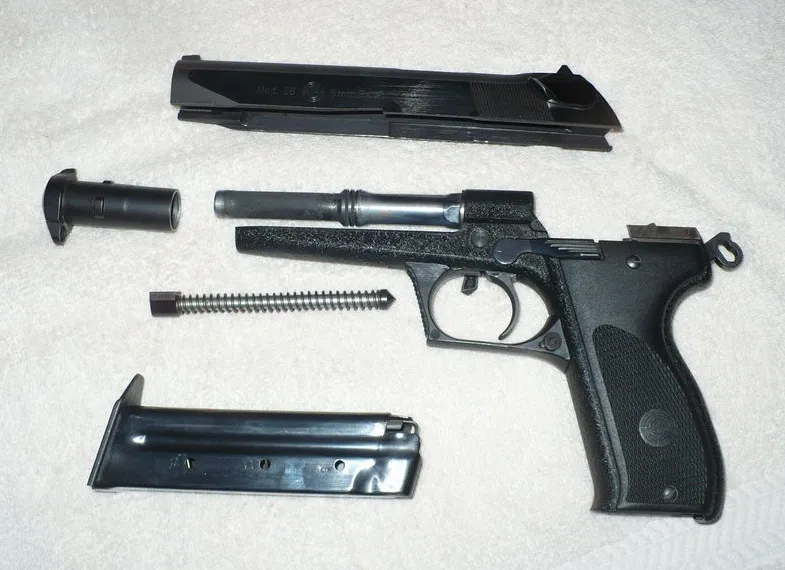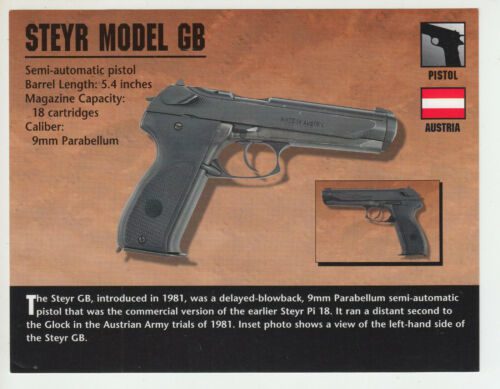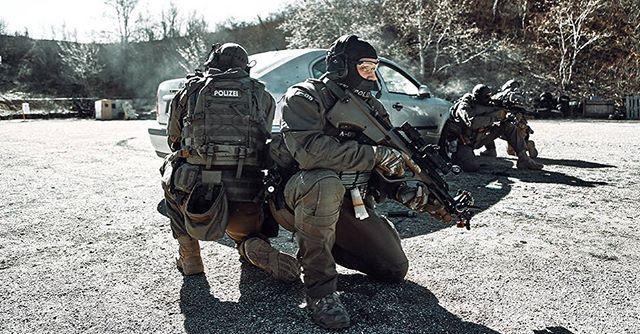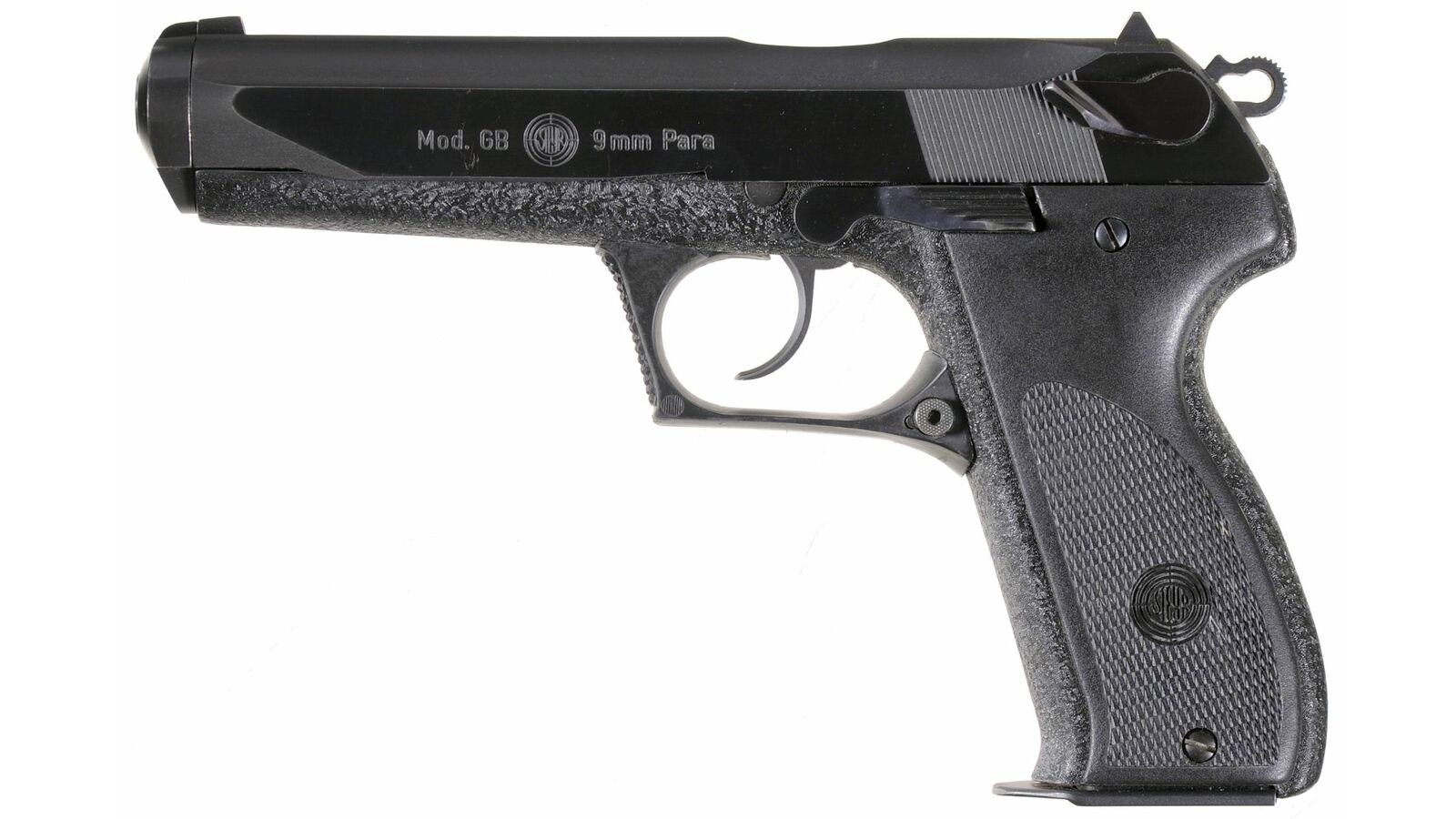Steyr GB is a semi-automatic pistol with all-steel construction, which was introduced as a game-changer in the world of firearms. Still, it was a commercial failure due to a lack of interest and no military orders. The Steyr GB has a high-capacity magazine and demonstrated outstanding performance in first interactions, but it was still not enough for significant success.
Introduction
Featuring new features and quite a different method of operation, unusual for modern firearms, Steyr GMbH meant the Steyr GB to replace Walther P-38 and Browning Hi-Power pistols, both of which were still in Austrian service at the end of the 1960s. These pistols were abundant in the Austrian military inventory and were time-tested and battle-proven weapons still in widespread use all over the world, so replacing them was a tall order to fill, even with the Austrian military’s growing interest in a new pistol.
Steyr GB is shorthand for “Gas Bremse,” meaning literally “Gas Brake,” which refers to its operation method.
Production
When Steyr GB entered production, the market competition was already heavy. The Western Bloc pistol market was also crowded with a wide range of 9 mm and .45 ACP weapons that were also competent performers, and it was obvious that it was going to take an exceptional firearm to convince the Austrian military to buy a weapon from Steyr. To that end, Steyr endeavored to produce a pistol that was unprecedented in design and performance, much the same as the Browning Hi-Power had been upon its introduction.
Steyr initiated the GB program in 1968 in response to a perceived market for a new service pistol in the Austrian military. Initially designated the Pi-18 in its infancy, the Steyr GB’s development was relatively sluggish by the standards of a company with Steyr’s resources, likely owing to its highly innovative and ambitious design. The first working prototypes were completed in 1974, but the design wasn’t refined enough for mass production until the end of the decade.
Design
Steyr GB has a distinct appearance, thanks to its rounded and contoured corners, rhombus-shaped trigger group, and sloped underside. The sights are low and contoured and set close to the receiver’s muzzle and the back end. The underside of the slide section and the front and back sides of the pistol grip usually have a rough “no-slip” finish. All Steyr GBs appear to have been completed in a dark grey finish, though Rogak P-18s were often completed with a nickel-plated finish, an omission of no-slip, and smoother grips.

The Steyr GB is composed almost entirely of carbon steel, with an exceptional high-strength finish. Early GBs also had steel grip panels, which were later replaced with plastic panels. The Rogak P-18 variant has an alternate stainless steel frame and plastic grip panels. The rifling is right-handed with six grooves and has a length of 136 mm.
Operating mechanism
The action of the Steyr GB is quite unusual for a modern pistol (or any firearm for that matter). While most semi-automatic pistols are blowback-operated, the action in the GB is also gas-delayed. This has a similar effect to the far more familiar lever-delayed and roller-delayed blowback operation methods in that it bleeds off some recoil energy via mechanical disadvantage, resulting in a weapon with very little “kick” or muzzle flip for its size and weight. Combined with the GB’s considerable weight, its recoil is exceptionally soft, even for a “Wondernine” pistol.
Steyr GB is unique because you load the ammunition directly in the top like you would a rifle magazine like an AR instead of pushing down and back, as you’d see in some of the other handgun magazines.

The way this pistol works is to insert a magazine put a round in the chamber, the hammer is cocked, hit the hammer drop, which bounces back up on its own, and your first shot is the very long double action trigger pull after the action cycles, the hammer is cocked, and all subsequent trigger pulls are the single short action and what is so typical of double action autoloaders is that even in single action mode there’s a lot of slop and some creep in that trigger this pistol has a really interesting design.
Ammunition
Ammunition is fed into the chamber via a detachable box magazine, whose well is located inside the grip. The staggered pattern of ammunition inside this “double stack” magazine allows it to hold 18 rounds without being excessively long. Without the double stack, the Steyr GB’s magazine capacity would be closer to 10 rounds.
A double-stack magazine is a full double-stack magnet that doesn’t come to a single point like most other guns.
Sights
The sights consist of a front blade and rear notch, both low-profile with white dot inserts. While this arrangement is relatively ordinary compared to most service pistols, it is distinguished by the fact that both are mounted on the slide; as such, there is no need to realign two major parts (i.e., the slide and barrel on most competing pistols) for accurate fire.
Production
Military market
The Steyr GB was finally presented to the Austrian armed forces in the early 1980s, alongside several competing designs. The Steyr firm was convinced that they would win the bid. After all, the principal opposition was a company that manufactured curtain rods, and their primary contribution to the Austrian military had been bayoneted. The body of their pistol was made of plastic. The owner of the company that made this competing weapon was also unheard-of in the firearms industry at the time; a man named Gaston Glock.
The Austrian Army found that this obscure dark horse, the Glock 17, had outstanding shooting and handling characteristics, thanks in part due to its almost entirely composite casing, which also made it light for its size. The magazine had almost the same capacity as the Steyr GB. While it was lighter and had a more basic blowback operation without a gas-delaying system, the increase in recoil wasn’t enough to make the Glock 17 either substantially less comfortable to fire or controllable. To make a long story short, the Steyr GB never stood a chance, and the Austrian military bought the Glock 17 instead.

Undaunted by their defeat, Steyr decided to try their luck in the most climactic service pistol bid of the 1980s, held by the US military. Finally willing to procure a successor to the venerable Colt M1911A1, the US military finally decided to procure a 9 mm Parabellum sidearm after nearly 70 years of resistance, and a high-capacity weapon was sought as well; the contract had “Steyr GB” written all over it, or so Steyr thought.
The US bid seemed to go well at first, but then again, so had the Austrian bid. While the GB did perform satisfactorily, it never made the finalists; the US military ended up in a virtual deadlock over whether to buy the SIG Sauer P226 or the Beretta Model 92, and the tie was finally broken only by a slightly more generous deal for Model 92 magazines. Defeated again, Steyr continued to market the GB to militaries across the globe, still without success. However, the loss of the US contract had changed their priority to selling the GB on the civilian and police markets.
Civilian Market
Production of the Steyr GB for the civilian market was finally initiated in 1981, with deliveries beginning in 1982. It was very well received by firearms publications and owners alike. Still, with only 15 000 to 20 000 produced (the sources for this article conflict with the production total), it was only modest commercial success on the civilian market, and Steyr ceased production in 1988. Only a very small number of military-grade Steyr GBs were ever produced, 50 of which were sold to the Austrian Army for testing and evaluation. The total number is unknown, though 937 examples eventually found their way into the US civilian market.
The civilian market proved disappointing as well, simply because the Steyr GB’s timing was so poor. By the mid-1980s, the “Wondernines” that nearly all private customers wanted were P226s, Beretta 92s, and Glock 17s. The average gun owner saw the Steyr GB as little more than a weapon that could be bought if there wasn’t anything else available. It was a dismal end to a gun that was not only far-sighted in concept but also a more competent contender than most potential buyers ever gave it credit for.

While the Steyr GB was still being developed, LES Incorporated of Morton Grove, Illinois, bought a license to manufacture a copy for civilian sale in the US. Designated the Rogak P-18, this pistol promised to improve even further upon the design formula of the GB by incorporating a stainless steel frame (a desirable attribute, as stainless steel, is exceptionally durable).
Unfortunately, the P-18 wasn’t as well-built on the inside as the GB was, and sloppy quality control practices resulted in actions that weren’t fully operable, failure to feed, and faulty extraction mechanisms.
The Steyr company was unsurprisingly quite livid when they found out what LES had done to the reputation of the GB and sued the US company, forcing LES to terminate P-18 production in 1980. Only a very small number of P-18s ever reached the market, with most sources stating that some 2 300 were produced. However, Ian McCollum of the Forgotten Weapons site disputes this figure, stating that the production run was closer to 1,000 weapons.
Current production status
There has been no production of the Steyr GB since 1988, and Steyr has effectively abandoned all further sales efforts, so new Steyr GBs are no longer available. More than 10,000 Steyr GBs remain on the civilian market and are sought-after by collectors, but their value has dramatically diminished; used GBs are often sold for as little as $200, even in pristine condition, simply because they’re so obscure.
By late 2017, there were no plans to revive the production of the Steyr GB. Now Steyr GB is regarded as a collector item, while the original model commands higher prices in the American market. It means this pistol is no longer being manufactured and hasn’t been in quite a few years, so you can’t run to the local gun stores and order one. There are still some gun brokers and places like that.
Steyr GB is very accurate, very reliable, and ergonomically designed. Still, it’s a user-friendly gun for a lot of people now, there’s one other selling point of this gun, and I know this isn’t supposed to matter, but it sometimes does, and that’s the fact that this gun is excellent and that can be a big selling point.
Technical specifications
| Country of origin: | Austria |
| Manufacturer: | Steyr Mannlicher GmbH & Co KG |
| Entered service: | – |
| Caliber: | 9×19 mm Parabellum |
| Weight (unloaded): | 0.85 kg |
| Weight (loaded): | 1.29 kg |
| Length: | 216 mm |
| Barrel length: | 136 mm |
| Muzzle velocity: | 350 m/s |
| Magazine capacity: | 18 rounds |
| Sighting range: | 50 m |
| Range of effective fire: | 50 m |

The pistols main fault was, it was too large and too heavy, especially for a 9×19. It was entirely impractical, if not (nearly) impossible to conceal, and for open carry, there are more powerful options.